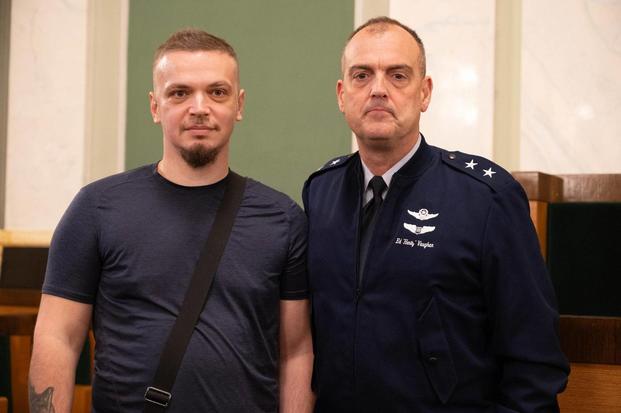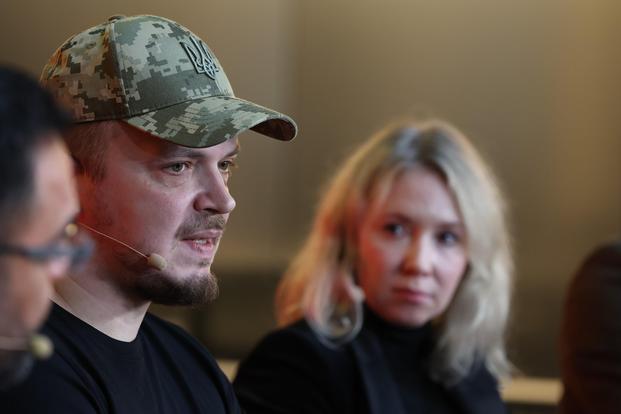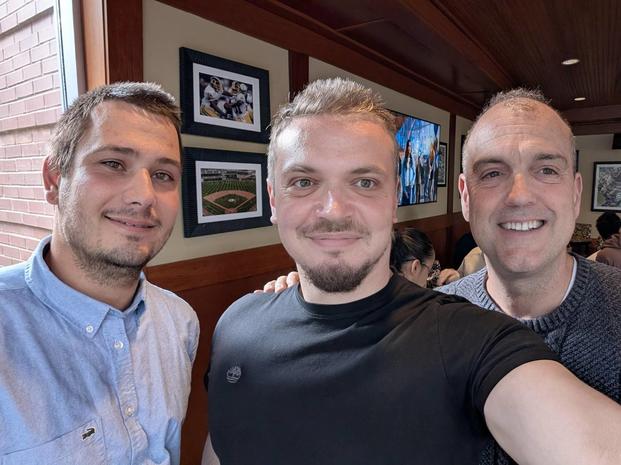This is the second of a two-part story.
Drones have dramatically altered the global paradigm of modern warfare, providing militaries and personnel worldwide with myriad capabilities on and off battlefields to subdue enemy attacks and infiltrate foreign territory. One foreign volunteer to Ukraine’s Armed Forces has translated his wartime experience to boost the next generation of electronic combat.
The next iteration of military prowess is already here, in the form of aerial devices that continue to transform real-time tactics in terms of reconnaissance, surveillance and logistics. Ongoing conflicts in Eastern Europe and Gaza continue to show the importance of electronics in both defense and strike capabilities.
Jack de Santis has firsthand witnessed how drones and elevated technology can improve a country’s broader military structure. The 34-year-old drone pilot and engineer originally from Croatia lent his expertise to Ukraine’s military for about two years, between December 2022 and January 2025, to boost technological capabilities and better equip Ukraine against Russian aggression and retaliation.
He is the founder of Omira Systems AI, described as a “next generation self-healing communications system” that aims to shift centuries-old battlefield tactics to conform to the current age of technological capabilities that have already impacted various parts of the world.
‘Stalemate’ Caused By Draconian Tactics
Jack de Santis had no prior military experience prior to risking his own life to help the Ukrainians in 2022, spurred by the conflict in the Balkans in his home region that impacted his decision decades later to lend his own hand.
While being green on the battlefield, he utilized his background in computer hardware engineering and piloting drones to try to encourage military personnel to pursue more contemporary forms of warfare.
The task was perhaps more difficult than envisioned, with de Santis saying that in the first of the Russia-Ukraine War “the bureaucracy of a conventional military came in, and that’s where the war really turned into a stalemate.”
“There are a couple of things that happened there, other than the change of the head of the [Ukrainian] Armed Forces that turned it into a stalemate,” he said. One is, in the first year of the war, there were several missed opportunities for the Ukrainians to really break through and to really kick out the Russians before the Russians managed to get their act together. They were also very disorganized in the first year.
“They also, with time, managed to build fortified positions and entrench themselves in, which would make it a lot harder today to kick them out than it would have been in the first year. And a big part of the reason why those opportunities were missed in the first year was due to hesitation from Western partners.”
That insinuated hesitancy on behalf of the then-Biden administration to potentially be more aggressive, which de Santis believes was a position derived from hesitancy and hurling into World War III, had further repercussions.
There were also the technical beliefs of war that stemmed from top military leaders in Ukraine, many of whom gained their knowledge from the Soviet Union and possess decades-old war acumen that may not translate well to the present.
“It is really such a stark contrast between having this trench warfare and Soviet-style tactics,” de Santis said. “A lot of Ukrainian officers were trained to become officers in Moscow, so they have this very old school, almost World War II-type mentality of how to conduct warfare.
“And at the same time, you also have all of this drone warfare, electronic warfare, and all of this high-tech stuff happening all at the same time, all kind of mashed together. It is really fascinating at times.”
He said that since Russia’s invasion in February 2022, the Ukrainian military has been going through “a big internal struggle to modernize itself” and veer away from that Soviet-era mentality. American military personnel have also pushed for Ukraine to modernize its forces and switch to a more Western-style combined arms warfare approach.
“But it’s hard to teach a 65-year-old general new tricks, so to say,” de Santis said.
‘One problem in common’
During his time in Ukraine, which included running Ukraine’s White Ghost drone program and working with volunteer fighters known as the Dark Angels, de Santis split between fighting and working on technology with the military.
He worked on numerous systems including flying drones, ground drones, naval drones, electronic warfare, battery and power solution, and radio technology.

“But of all of the things that I worked on during my time in Ukraine, I really saw everything had this one problem in common, and that was jamming and electronic warfare,” he said. “It was disrupting everything from battlefield tactics and being able to coordinate in real time on the battlefield.
“This is also one of the biggest blockers why Ukraine [is], let’s say, slowing down the adoption of combined arms warfare in the Ukrainian military. It’s the inability to communicate on the battlefield because comms are always jammed.”
Jamming is known more colloquially as intentionally interfering with enemies’ electromagnetic signals to disrupt their communications, radar and navigation systems by means of sending false signals or creating noise that infiltrates opposing forces.
“You can’t really have a commander sitting in the back coordinating things in real time; you cannot have the guys who are in the battle reporting back to command what they’re seeing, what is happening,” de Santis said. “It makes combined arms warfare almost impossible that way.
“Also, other things like calling for backup or calling for a medevac [medical evacuation] are almost impossible because the majority of the time you’re constantly working. So, one of your guys in your unit is wounded during a combat operation, you are on your own to evacuate to at least the closest position from where you can receive further aid.”
A lot of drones are now switching to fiber optic cables due to jamming and the spectrum being so congested, he added.
Developing New Technologies
Omira AI was a mission embarked upon years ago.
Brainstorming by de Santis began back in 2023, pondering what could be done about jamming and elevating internal electronic systems. That included conversations with the Ukrainian Army Corps of Engineers.
He came up with a new method to communicate and conduct radio broadcasting that he said is “completely new and unlike any other radio that has ever been built before, both civilian and military.”
That translated to working on an extra-wide spectrum, from 100 megahertz to 8 gigahertz, picking frequencies by being aware of nearby spectrums and using multiple frequencies at the same time in a redundant manner.
“This is based off what I identified on the battlefield as being like the main bottleneck of jamming technology, and that it’s how much power you need to jam a single frequency,” he said. “And then the wider you want to go with a jammer, it gets pretty crazy pretty quickly.”

Some of the largest Russian systems are composed of multiple command trucks that together compose an electronic attack system, yet he said they can still only jam about 500 megahertz of spectrum at once. However, that’s enough to cover all of the bands that the U.S. military has conventionally been allowed to use.
All of the NATO standard radios are also pretty useless because the Russians developed the technology that covers the entire band that those radios are using, he added, which is equivalent to frequency hopping within a block of a completely jammed spectrum where “you’re not really going anywhere.”
“This is where Omira came [from], just as out of frustration on the battlefield, watching my drones drift away and I’ve been watching my friends die because they couldn’t call for a medevac or they couldn’t call for backup,” de Santis said.
Advancing Tech in the U.S.
By early 2024, de Santis started networking with different current and retired military personnel as a means of eliciting funding to bring networking systems to the next stage of technology readiness.
He has met with ex-U.S. Air Force service members, U.S. Army personnel, the National Guard, and even members of the CIA—the latter of whom told him that tech being developed by Omira and counterparts are “several generations ahead of anything else out there.”
That has led him into inner circles in Washington D.C., working in tandem on this newer technology now with the U.S. government—receiving support from the highest levels of the Pentagon, Department of Defense, and lawmakers in Congress.
“It took me a long time to convince anybody in Europe or in the U.S. that this is something important and that this is something that we should be paying attention to and probably even more attention than drones,” he said. “I always tell people here, the Russians and the Chinese invested billions and billions of dollars into developing their electronic warfare capability. While their capability is less high-tech than what the U.S. has, it’s far greater in numbers.
“In the Russian military, every squad basically has a jammer with them. Every vehicle on the battlefield has a jammer with them. And even the Ukrainians are still playing catch-up in terms of electronic warfare capabilities and the sheer quantity of it.”

He routinely attends conferences in the states—like the U.S. Army National Guard conferences, for example—to forge relationships in this space. His message to partners and allies is a simple one: move fast or get left behind.
In the U.S., electronic warfare has been considered very niche, high-tech and specialized. Meanwhile, de Santis points out how adversaries choose to invest a lot n electronic warfare when they could have taken the same amount of money and built a bunch of planes or aircraft carriers, etc.
“It’s because they understood that by denying the U.S. communication and coordination in real time, they make our combined arms warfare doctrine impossible to do,” he said. “And that’s where things fall apart and we don’t know how to fight without combined arms warfare.
“Those are things that the US and our allies are not training and not preparing for at all. We rely so much on coordination and communication on the battlefield, and we are not really looking at it and not really paying attention to what is happening or developing even theoretical procedures for how to fight in such a scenario.”
Artificial intelligence on the battlefield is another goal, though de Santis acknowledges that he’s never seen AI or autonomous drones on the battlefield aside from one-off prototypes.
“I got to sit down in a room with five generals from the Army, Air Force and National Guard [following one conference in Milwaukee] and brief them more in depth on drone warfare and the realities of it,” he said. “We booked one hour, we ended up speaking for 3 1/2 hours.
“That was pretty surreal for me to sit down with five U.S. generals and to be briefing them and sharing knowledge with them. But this really opened my eyes on one, how much we take the most basic information that we take for granted in Ukraine; how much NATO and U.S. troops don’t know about those things.”
He added: “It got me thinking that with me and with my guys from Ukraine, I could really start putting together a program for training the U.S. military in drone warfare because we have experienced everything from squad level, all the way to battalion and brigade level.
“I worked my way up in Ukraine from drone pilot all the way to advisor to the battalion commander for drone and electronic warfare. … There is really a lot we could teach the U.S. military.”
Story Continues
Read the full article here





